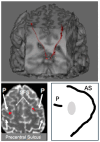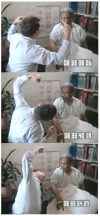Seeing without a Scene: Neurological Observations on the Origin and Function of the Dorsal Visual Stream
- PMID: 38786652
- PMCID: PMC11121949
- DOI: 10.3390/jintelligence12050050
Seeing without a Scene: Neurological Observations on the Origin and Function of the Dorsal Visual Stream
Abstract
In all vertebrates, visual signals from each visual field project to the opposite midbrain tectum (called the superior colliculus in mammals). The tectum/colliculus computes visual salience to select targets for context-contingent visually guided behavior: a frog will orient toward a small, moving stimulus (insect prey) but away from a large, looming stimulus (a predator). In mammals, visual signals competing for behavioral salience are also transmitted to the visual cortex, where they are integrated with collicular signals and then projected via the dorsal visual stream to the parietal and frontal cortices. To control visually guided behavior, visual signals must be encoded in body-centered (egocentric) coordinates, and so visual signals must be integrated with information encoding eye position in the orbit-where the individual is looking. Eye position information is derived from copies of eye movement signals transmitted from the colliculus to the frontal and parietal cortices. In the intraparietal cortex of the dorsal stream, eye movement signals from the colliculus are used to predict the sensory consequences of action. These eye position signals are integrated with retinotopic visual signals to generate scaffolding for a visual scene that contains goal-relevant objects that are seen to have spatial relationships with each other and with the observer. Patients with degeneration of the superior colliculus, although they can see, behave as though they are blind. Bilateral damage to the intraparietal cortex of the dorsal stream causes the visual scene to disappear, leaving awareness of only one object that is lost in space. This tutorial considers what we have learned from patients with damage to the colliculus, or to the intraparietal cortex, about how the phylogenetically older midbrain and the newer mammalian dorsal cortical visual stream jointly coordinate the experience of a spatially and temporally coherent visual scene.
Keywords: Bálint’s syndrome; hemispatial neglect; parietal lobe; progressive supranuclear palsy; superior colliculus.
Conflict of interest statement
The author declares no conflicts of interest.
Figures

















Similar articles
-
Beyond the labeled line: variation in visual reference frames from intraparietal cortex to frontal eye fields and the superior colliculus.J Neurophysiol. 2018 Apr 1;119(4):1411-1421. doi: 10.1152/jn.00584.2017. Epub 2017 Dec 20. J Neurophysiol. 2018. PMID: 29357464 Free PMC article.
-
Compensating for a shifting world: evolving reference frames of visual and auditory signals across three multimodal brain areas.J Neurophysiol. 2021 Jul 1;126(1):82-94. doi: 10.1152/jn.00385.2020. Epub 2021 Apr 14. J Neurophysiol. 2021. PMID: 33852803 Free PMC article.
-
Position and Identity Information Available in fMRI Patterns of Activity in Human Visual Cortex.J Neurosci. 2015 Aug 19;35(33):11559-71. doi: 10.1523/JNEUROSCI.0752-15.2015. J Neurosci. 2015. PMID: 26290233 Free PMC article.
-
Here, there and everywhere: higher visual function and the dorsal visual stream.Pract Neurol. 2016 Jun;16(3):176-83. doi: 10.1136/practneurol-2015-001168. Epub 2016 Jan 19. Pract Neurol. 2016. PMID: 26786007 Review.
-
The tectum/superior colliculus as the vertebrate solution for spatial sensory integration and action.Curr Biol. 2021 Jun 7;31(11):R741-R762. doi: 10.1016/j.cub.2021.04.001. Curr Biol. 2021. PMID: 34102128 Free PMC article. Review.
Cited by
-
Cognivue Clarity® characterizes amyloid status and preclinical Alzheimer's disease in biomarker confirmed cohorts in the Bio-Hermes Study.J Alzheimers Dis. 2025 Mar;104(1):83-94. doi: 10.1177/13872877251314117. Epub 2025 Jan 26. J Alzheimers Dis. 2025. PMID: 39865688 Free PMC article.
References
-
- Bálint Rezsö. Seelenlahhmung edes “Schauens”, optische Ataxie, raumliche Storung der Aufmerksamkeit. Montschrife Pscyhiatrie und Neurologie. 1909;25:51–81. doi: 10.1159/000210464. - DOI
LinkOut - more resources
Full Text Sources

